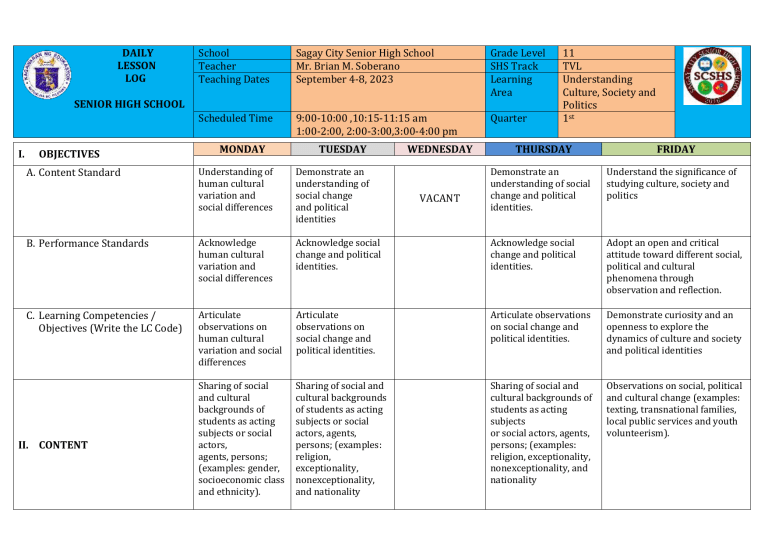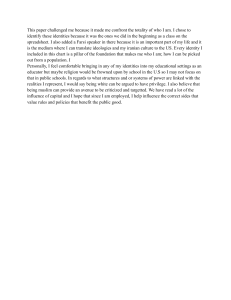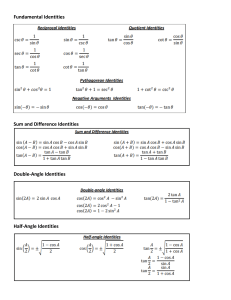
DAILY LESSON LOG School Teacher Teaching Dates Sagay City Senior High School Mr. Brian M. Soberano September 4-8, 2023 Grade Level SHS Track Learning Area Scheduled Time 9:00-10:00 ,10:15-11:15 am 1:00-2:00, 2:00-3:00,3:00-4:00 pm Quarter SENIOR HIGH SCHOOL I. OBJECTIVES MONDAY TUESDAY Understanding of human cultural variation and social differences Demonstrate an understanding of social change and political identities B. Performance Standards Acknowledge human cultural variation and social differences C. Learning Competencies / Objectives (Write the LC Code) A. Content Standard II. CONTENT WEDNESDAY 11 TVL Understanding Culture, Society and Politics 1st THURSDAY FRIDAY Demonstrate an understanding of social change and political identities. Understand the significance of studying culture, society and politics Acknowledge social change and political identities. Acknowledge social change and political identities. Adopt an open and critical attitude toward different social, political and cultural phenomena through observation and reflection. Articulate observations on human cultural variation and social differences Articulate observations on social change and political identities. Articulate observations on social change and political identities. Demonstrate curiosity and an openness to explore the dynamics of culture and society and political identities Sharing of social and cultural backgrounds of students as acting subjects or social actors, agents, persons; (examples: gender, socioeconomic class and ethnicity). Sharing of social and cultural backgrounds of students as acting subjects or social actors, agents, persons; (examples: religion, exceptionality, nonexceptionality, and nationality Sharing of social and cultural backgrounds of students as acting subjects or social actors, agents, persons; (examples: religion, exceptionality, nonexceptionality, and nationality Observations on social, political and cultural change (examples: texting, transnational families, local public services and youth volunteerism). VACANT III. LEARNING RESOURCES A. References 1. Teacher’s Guide pages 2. Learners’ Materials pages 3. Textbook pages 4. Additional Materials from Learning Resources Portals B. Other Learning Resources IV. PROCEDURES A. Reviewing previous lesson or presenting the new lesson Present the topic to the learners Reviewing previous lesson and present the new lesson Present the objectives of the lesson Reviewing previous lesson and present the new lesson Present the objectives of the lesson Review past lessons B. Establishing a purpose for the lesson Present the objectives of the lesson Define LGBT and the purpose of the group Name past and present recreation of Ilonggos Discuss the wearing of Abaya among Muslim women Discussion Define social change and political identities Discussion Discussion Discussion F. Developing mastery (Leads to Formative Assessment 3) Discussion Discussion Discussion Discussion G. Finding practical applications of concepts and skills in daily living Discuss your gender roles Discuss the changes of the community List down the names of the local officials in your Community. Give the significance of studying culture, society as your perceptions about Politics. H. Making generalizations and abstractions about the lesson I. Evaluating learning Summary of the lesson Describe your culture by using your name (Acoustic) Summary of the lesson Summary of the lesson Summary of the lesson Form 4 groups. Cite 10 changes that happened in your community in the last 10 years. Explain the advantages and disadvantages brought about by modernization as part of social change. C. Presenting Examples/ instances of the new lesson D. Discussing new concepts and practicing new skills #1 Present the objectives of the lesson E. Discussing new concepts and practicing new skills #2 Form 3 groups. 1st groupDiscuss 10 cultura practices all over Philippines. 2nd group- 10 unique cultura practices from different provinces. 3rd group- 10 changes in the cultural practices of Filipinos J. Additional activities for application or remediation V. REMARKS VI. REFLECTION A. No. of learners who earned 80% in the evaluation. B. No. of learners who require additional activities for remediation C. Did the remedial lessons work? No. of learners who have caught up with the lesson. D. No. of learners who continue to require remediation. E. Which of my teaching strategies worked well? Why did it work? F. What difficulties did I encounter which my principal or supervisor can help me solve? G. What innovation or localized materials did I used/discover which I wish to share with other learners? Prepared by: Brian M. Soberano Volunteer Checked by: Jona A. Esmalla Principal II

